Command line
Unix-like operating systems are built under the model of free and open-source development and distribution. They often come with a graphical user interface (GUI) and can be run from the command line (CLI) or terminal. The CLI is a text-based interface that works exactly the same way as you would use your mouse, but you use words.
It is important to know how to use the terminal as all servers, and most bioinformatics tools, do not have a GUI and rely on the use of the terminal.
For this course, we will use a GUI for some parts, but all our interaction with the remote server will be on the command line. As such, it’s important that you know your way around the command line.
I know that you have varying experience with the command line. The following tutorial gives an excellent overview over the basics (and not so basics). If you have already worked with the command line it will probably be enough to browse and brush up on some parts, if you haven’t this will be your chance to learn:
The above tutorial is designed to be taken on your local machine, where you have a home directory and a Desktop.
You can also follow the tutorial on the course server. However, you won’t have a Desktop there, and will have to adjust accordingly.
If you want to follow the course on the server you can download the tutorial data with:
curl https://swcarpentry.github.io/shell-novice/data/shell-lesson-data.zip -o shell-lesson-data.zip Then decompress with:
unzip shell-lesson-data.zip 